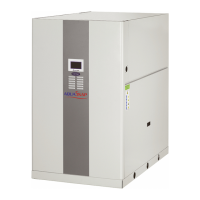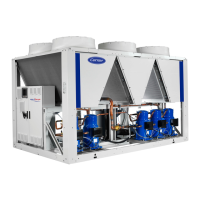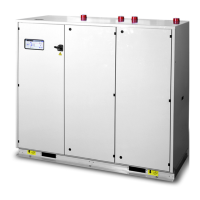6
1 - INTRODUCTION
1.2 - Equipment and components under
pressure
These products incorporate equipment or components under
pressure,
We recommend that you consult your appropriate national trade
association or the owner of the equipment or components under
pressure (declaration, re-qualification, retesting, etc.). The
characteristics of this equipment/these components are given on
the nameplate or in the required documentation, supplied with the
products.
These units are intended to be stored and operated in an
environment where the ambient temperature must be not less
than the lowest allowable temperature indicated on the nameplate.
Do not introduce signicant static or dynamic pressure with
regard to the operating pressures used during operation or
for tests in the refrigerant circuit or in the heat exchange
circuits.
1.3 - Maintenance safety considerations
Manufacturer recommends the following drafting for a logbook
(the table below should not be considered as reference and does
not involve the manufacturer responsibility):
Intervention Name of the
commissioning
engineer
Applicable
national
regulations
Verication
Organism
Date Nature
(1)
(1) Maintenance, repairs, regular verications (EN 378), leakage, etc.
Engineers working on the electric or refrigeration components
must be authorised, trained and fully qualied to do so (e.g.
electricians trained and qualied in accordance with IEC 60364
classication BA4).
All refrigerant circuit repairs must be carried out by a trained
person, fully qualied to work on these units. He must have been
trained and be familiar with the equipment and the installation. All
welding operations must be carried out by qualied specialists.
Any manipulation (opening or closing) of a shut-off valve
must be carried out by a qualied and authorised engineer.
These procedures must be carried out with the unit shut down.
Any intervention on the refrigerant circuit, including changing
of drier blocks, is only permitted after the complete removal
of the refrigerant charge. For these units transfer of the
refrigerant charge from the high or low-pressure side is not
possible, nor permitted.
Never use the compressor as a vaccum pump.
Equip the engineers that work on the unit as follows:
Personal protection
equipment (PPE)
(1)
Operations
Handling
maintenance,
service
Welding or
brazing
(2)
Protective gloves, eye
protection, safety shoe,
protective clothing.
X X X
Ear protection. X X
Filtering respirator. X
(1) We recommend to follow the instructions in EN 378-3.
(2) Performed in the presence of A1 refrigerant according to EN 378-1.
Never work on a unit that is still energised.
Never work on any of the electrical components, until the
general power supply to the unit has been cut using the
disconnect switch in the control box.
If any maintenance operations are carried out on the unit,
lock the power supply circuit in the open position ahead of
the machine.
If the work is interrupted, always ensure that all circuits are
still deenergized before resuming the work.
ATTENTION: Even if the compressor motors have been
switched off, the power circuit remains energized, unless the
unit or circuit disconnect switch is open. Refer to the wiring
diagram for further details.
Attach appropriate safety labels.
It is recommended to install an indicating device to show if
part of the refrigerant has leaked from the safety relief valve.
The presence of oil at the outlet orice is a useful indicator
that refrigerant has leaked. Keep this orice clean to ensure
that any leaks are obvious. The calibration of a valve that has
leaked is generally lower than its original calibration. The new
calibration may affect the operating range. To avoid nuisance
tripping or leaks, replace or re-calibrate the safety relief valve.
Operating checks:
- Important information regarding the refrigerant used:
- This product contains fluorinated greenhouse gas
covered by the Kyoto protocol.
- Fluid type: R410A
- Global Warming Potential (GWP): 2088
CAUTION:
1. Any intervention on the refrigerant circuit of this product
should be performed in accordance with the applicable
legislation. In the EU, the regulation is called F-Gas,
N°517/2014.
2. Ensure that the refrigerant is never released to the
atmosphere during installation, maintenance or equipment
disposal.
3. The deliberate gas release into the atmosphere is not
allowed.
4. If a refrigerant leak is detected, ensure that it is stopped
and repaired as quickly as possible.
5. Only a qualied and certied personnel can perform
installation operations, maintenance, refrigerant circuit
leak test as well as the equipment disposal and the
refrigerant recovering.
6. The gas recovery for recycling, regeneration or destruction
is at customer charge.
7. Periodic leak tests have to be carried out by the customer
or by third parties. The EU regulation set the periodicity
here after:
System WITHOUT
leakage detection
No Check 12 Months 6 Months 3 Months
System WITH
leakage detection
No Check 24 Months 12 Months 6 Months
Refrigerant charge/
circuit (CO
2
equivalent)
< 5 Tons
5 ≤ Charge
< 50 Tons
50 ≤
Charge
< 500 Tons
Charge
> 500
Tons*
Refrigerant charge/
Circuit (kg)
R134A
(GWP
1430)
Charge
< 3.5 kg
3.5 ≤
Charge
< 34.9 kg
34.9 ≤
Charge
< 349.7 kg
Charge
> 349.7 kg
R407C
(GWP
1774)
Charge
< 2.8 kg
2.8 ≤
Charge
< 28.2 kg
28.2 ≤
Charge
< 281.9 kg
Charge
> 281.9 kg
R410A
(GWP
2088)
Charge
< 2.4 kg
2.4 ≤
Charge
< 23.9 kg
23.9 ≤
Charge
< 239.5 kg
Charge
> 239.5 kg
HFO’s:
R1234ze
No requirement
(1) From 01/01/2017, units must be equipped with a leakage detection system
8. A logbook must be established for equipments subject to
periodic leak tests. It should contain the quantity and the
type of uid present within theinstallation (added and
recovered),the quantity ofrecycleduid,regeneratedor
destroyed, the date and output of the leak test, the
designation of the operator and its belonging company,
etc.

